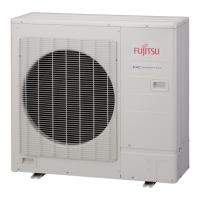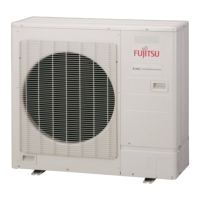En-7
5.4. Sealing test
WARNING
Before operating the compressor, install the pipes and securely connect them.
Otherwise, if the pipes are not installed and if the valves are open when the
compressor operates, air could enter the refrigeration cycle. If this happens, the
pressure in the refrigeration cycle will become abnormally high and cause damage or
injury.
After the installation, make sure there is no refrigerant leakage. If the refrigerant leaks
into the room and becomes exposed to a source of re such as a fan heater, stove, or
burner, it produces a toxic gas.
Do not subject the pipes to strong shocks during the sealing test. It can rupture the
pipes and cause serious injury.
CAUTION
Do not block the walls and the ceiling until the sealing test and the charging of the
refrigerant gas have been completed.
For maintenance purposes, do not bury the piping of the outdoor unit.
After connecting the pipes, perform a sealing test.•
Make sure that the 3-way valves are closed before performing a sealing test.•
Pressurize nitrogen gas to 4.15 MPa to perform the sealing test.•
Add nitrogen gas to both the liquid pipes and the gas pipes.•
Check all are connections and welds. Then, check that the pressure has not •
decreased.
Compare the pressures after pressurizing and letting it stand for 24 hours, and check •
that the pressure has not decreased.
* When the outdoor air temperature changes 5 °C, the test pressure changes
0.05 MPa. If the pressure has dropped, the pipe joints may be leaking.
If a leak is found, immediately repair it and perform the sealing test again.•
After completing the sealing test, release the nitrogen gas from both valves.•
Release the nitrogen gas slowly.•
5.5. Vacuum process
CAUTION
Perform a refrigerant leakage test (air tightness test) to check for leaks using nitrogen
gas while all valves in the outdoor unit are closed. (Use the test pressure indicated on
the nameplate.)
Be sure to evacuate the refrigerant system using a vacuum pump.
The refrigerant pressure may sometimes not rise when a closed valve is opened after
the system is evacuated using a vacuum pump. This is caused by the closure of the
refrigerant system of the outdoor unit by the electronic expansion valve. This will not
affect the operation of the unit.
If the system is not evacuated sufciently, its performance will drop.
Use a clean gauge manifold and charging hose that were designed specically for use
with R410A. Using the same vacuum equipment for different refrigerants may damage
the vacuum pump or the unit.
Do not purge the air with refrigerants, but use a vacuum pump to evacuate the system.
(1) Check that the valves are closed by removing the blank caps from the gas and
liquid pipes.
(2) Remove the charging port cap, and connect the gauge manifold and the vacuum
pump to the charging valve with the service hoses.
(3) Vacuum the indoor unit and the connecting pipes until the pressure gauge
indicates –0.1 MPa (–76 cmHg).
(4) When –0.1 MPa (–76 cmHg) is reached, operate the vacuum pump for at least 60
minutes.
(5) Disconnect the service hoses and t the charging port cap to the charging valve to
the specied torque. (Refer to below table)
(6) Remove the blank caps, and fully open the spindles of 3-way valves with a
hexagon wrench [Torque: 6 to 7 N·m (60 to 70 kgf·cm)].
(7) Tighten the blank caps of the 3-way valve to the specied torque.
(Refer to Table A in the previous page)
Tightening torque [N·m (kgf·cm)]
Charging port cap
10 to 12 (100 to 120)
Spindle
Service hose
Service hose with valve core
Charging port
Blank cap
Hexagon wrench
Connecting pipe
Gauge manifold
Vacuum pump
Charging port cap
3-way valve
Use a 4 mm
hexagon
wrench
Pressure regulating valve
Pressure gauge
Nitrogen
Indoor unit
Outdoor unit
Vacuum pump
5.6. Additional charging
WARNING
When moving and installing the air conditioner, do not mix gas other than the specied
refrigerant R410A inside the refrigerant cycle.
If air or other gas enters the refrigerant cycle, the pressure inside the cycle will rise to
an abnormally high value and cause breakage, injury, etc.
CAUTION
After vacuuming the system, add refrigerant.
Do not reuse recovered refrigerant.
When charging the refrigerant R410A, always use an electronic scales for refrigerant
charging (to measure the refrigerant by weight). Adding more refrigerant than the
specied amount will cause a malfunction.
When charging the refrigerant, take into account the slight change in the composition
of the gas and liquid phases, and always charge from the liquid phase side whose
composition is stable. Adding refrigerant through the gas pipe will cause a malfunction.
Check if the steel cylinder has a siphon installed or not before lling. (There is an
indication “with siphon for lling liquid” on the steel cylinder.)
Filling method for cylinder with siphon
R410A
Gas
Liquid
Set the cylinder vertical and ll with the liquid.
(Liquid can be lled without turning bottom up with the siphon
inside.)
Filling method for other cylinders
R410A
Gas
Liquid
Turn bottom up and ll with liquid.
(Be careful to avoid turning over the cylinder.)
Be sure to use the special tools for R410A for pressure resistance and to avoid mixing
of impure substances.
If the units are further apart than the maximum pipe length, correct operation can not
be guaranteed.
Make sure to back closing valve after refrigerant charging. Otherwise, the compressor
may fail.
Minimize refrigerant release to the air. Excessive release is prohibited under the Freon
Collection and Destruction Law.
